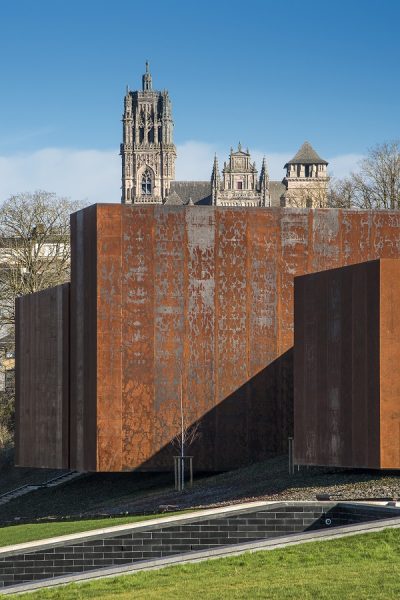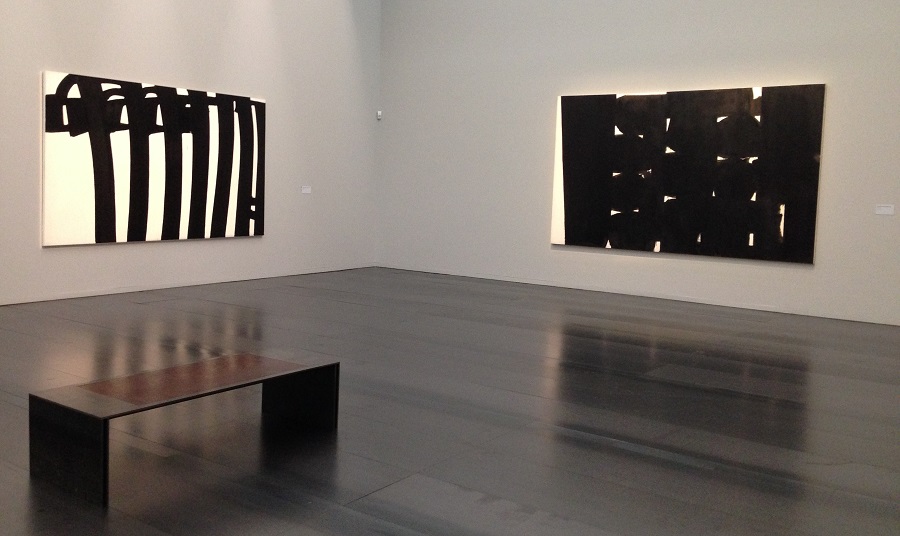
Above: Soulages Museum, Rodez © RCR, photo B. Bonnefon
Corinne LaBalme saw only the dark side of Pierre Soulages, France’s most celebrated living artist, until she visited his namesake museum in Rodez, Aveyron, and saw the light.
Pierre Soulages is the rare artist who’s been able to attend his own centenary celebrations. Born in 1919, he’s been prolific enough to have filled countless retrospectives around the world last year. But age alone doesn’t explain why prices for his work have reached dizzying heights, as his work entitled “200 x 166 cm 14 mars 1960,” which sold for 9.6 million euros (about 10.5 million dollars) in November 2019. (When it comes to Soulages titles it’s just the facts: size and date completed.) There is something extraordinary about his work, though I didn’t realize it until I visited his namesake museum in Rodez, his birthplace in the Aveyron department of central southern France.
Soulages is best known for working within the realm of outrenoir, which is often translated in English as “ultra-black” or “beyond black.” He coined the word in 1979 to describe paintings that he coated in thick black pigment before meticulously raking them into shape with masonry tools generally used on grout and mortar.
“The vehicle is light, not black,” the artist has explained numerous times. “Black is a violent color, it imposes itself, it dominates, it’s the original color.”
Nevertheless, his Darth Vader-ish canvases never imposed themselves on me. While they were instantly recognizable in contemporary art exhibits, my own magpie attention was always diverted by the turquoise Hockney swimming pools or the neon Warhols that flanked them. Once you’ve seen one big Soulages, you’ve seen them all, I thought.
Wrong.

It took a press trip to Rodez, a town so isolated in the volcanic plateaux of central France that the “fast” trains from Paris take seven hours to get there, to alter my perception of Soulages’ outrenoir. Seeing mass quantities of his paintings in a building that was purpose-built to show them off can be a mind-bending, magical and quasi-religious experience—my Come-to-Gesso experience.
In 2005, Soulages donated 500 of his works to the municipality of Rodez. (He now resides in Sète, the nearest Mediterranean town to Rodez.) Until the completion of the museum in 2014, Rodez’s sole main architectural claim to fame was its red sandstone Notre-Dame Cathedral (1276-1531). The museum, designed by the Catalan architectural firm of RCR, now also holds a claim. It consists of five slightly tippy parallelepiped boxes set in a 7.4-acre garden in the center of town. Its rusty Corton steel façade echoes the red sandstone of the Gothic cathedral that stands 600 yards away. (In 2017 the firm won the Pritzker Architecture Prize.)
As the artist has repeatedly told interviewers, his outrenoir painting are all about the light. Yet when I’ve seen his work in group shows, the industrial lumens that make Motherwells and Pollocks sparkle and shine left Soulages looking like the designated driver at the art party. Soulages painting don’t photograph well either. They need to be experienced in motion i.e. the motion of the viewer.

The cavernous museum in Rodez, with its darkened rooms and large windows, allows the paintings to come alive while revealing their secrets. A canvas that appears from one angle to be somber as a moonless night in an urban blackout will from another angle burst into an array of molten golden shimmers.
It’s hard to say more about the outrenoir gold seam. It’s about as close to alchemy as anything yet seen on earth and thus, it has to be seen to be believed. His giant canvases with black motifs on a white field photograph much better but it’s only “in person” that you can detect the tiny splotches of dark paint which could have been easily whited out. People often compare these paintings to Chinese calligraphy, a simile that the artist has denied, yet there is a certain Eastern “drips happen” serenity of these paintings.

For a 100-year-old artist who’s been top of his game for decades, Soulages’ personal bio is surprisingly slim and uneventful. No escapades in Tahiti, no (recorded) drunken revels, no Picasso-esque psycho-drama. Soulages has even stayed married to the same woman, Colette Llaurens, since 1940! That means an 80th wedding anniversary this year, an accomplishment in itself.
Soulages’ instant success and seamless speed towards super-stardom leads me to think of him as the anti-Van Gogh. As a journalist who has had an achingly hard time trying to get a first novel published, 80 years of success is irritatingly hard to fathom. Accepted into Paris’s prestigious Ecoles des Beaux Arts in 1937, Soulages dropped out before day one after deciding that art school had nothing to teach him. After WWII, he was rejected from one salon (count it: one) and then became the undisputed star of his next group show in 1947. By the early 1950s, he’d exhibited in the Guggenheim, the Tate, MOMA, the Phillips in Washington, as well as museums and galleries in Rio, Copenhagen, Paris, etc., and the honors and recognition never stopped.
Even though painters naturally prefer pigment to prose, Pierre Soulages is more cryptic than most. When asked about his outrenoir oeuvre in the December 2019 issue of Connaissance des Arts magazine, he replied: Le mot outrenoir permet de ne pas se limiter au phénomene optique car voir les reflets sur une surface noir, c’est un phénomene optique. (The word outrenoir makes it possible to not limit oneself to the optical phenomenon because seeing the reflections on a black surface is an optical phenomenon.)
While maddeningly opaque in both French and English, this response would make perfect sense on Dagobah: Black see you not, Luke Skywalker. Light it must have to reveal the Force.
The events of 2020 have made the world seem like one huge black hole. Is there no better time to embrace the dark and find the light that lies within it? Pierre Soulages may not be the original Jedi Knight, but his artwork is certainly what I need right now.
Musée Pierre Soulages. Jardin du Foirail, avenue Victor Hugo, 12000 Rodez. Tel: 05 65 73 82 60. Hours: 9 am to 9 pm. Closed Monday. July and August: Open 7 days. Café Michel Bras on premises.
Note: The museum re-opened after Corona lockdown on May 21st. Masks will be obligatory until further notice. Through October 31, the museum will present a temporary exhibition entitled Femmes Années 50 that showcases the abstract works of Sonia Delaunay, Joan Mitchell, Geneviève Asse, Pierrette Bloch, Shirley Goldfarb and others.
© 2020, Corinne LaBalme for France Revisited


So nice not leaving my living room and learning so much! Thank you, Gary!
I’ll pass the thanks on to Corinne LaBalme, the faithful contributor who wrote the article.
He and his wife were married wearing black. His wife had a wedding dress made in a black material in 1942.